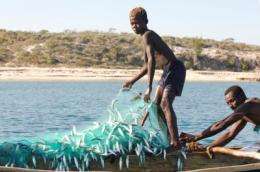Study IDs new marine protected areas in Madagascar

A new study by the University of California, Berkeley, Wildlife Conservation Society, and others uses a new scientific methodology for establishing marine protected areas in Madagascar that offers a "diversified portfolio" of management options – from strict no-take zones to areas that would allow fishing.
The methodology looks at existing information on the country's climate, along with dependence on fisheries and marine resources, and applies three different planning approaches to establish priorities for management along the entirety of Madagascar's west coast.
The diversified portfolio approach to marine conservation greatly increases the likelihood of finding and implementing successful management that fits a country's needs while simplifying the process of picking locations and the most appropriate forms of marine management, the authors say.
Considering the need to develop a management regime for the reefs and mangroves of Madagascar that factors in the impacts of climate change, the methodology recommends a range of conservation areas with strict no-take protection as only one type of management recommendation.
The paper appears in the February 16th issue of the open access journal PLoS One. Authors include: Thomas Allnut, Merrill Baker, and Claire Kremen of the University of California, Berkeley; Tim McClanahan, Caleb McClennen, Andry Rakotomanjaka, and Tantely Tianarisoa of the Wildlife Conservation Society; Erwann Lagabrielle and Serge Andrefouet of the Institut de Recherche pour le Développement; and Reg Watson of the University of British Columbia.
The authors say the process provides a more efficient and comprehensive way to plan on a large scale and found that several marine areas in Madagascar come out as conservation priorities across all methodologies. Specifically, these included reefs in the vicinity of the Barren Islands, the large shallow banks to the northwest and southwest, and the reefs of Juan de Nova.
The study highlights the differences in the country's regional patterns. These include heavy human pressure in the south and areas of high climate variability intermixed with lower vulnerability but high biodiversity in the northwest. Areas of particularly high biodiversity value include the islands, reefs, and bays of the northwest; the fringing reefs of the southwest; and the barrier reefs and islands of the central west coast.
Madagascar is one of the poorest countries on Earth yet has proposed to create over 1 million hectares (3,861 square miles) of protected areas to provide for the long-term conservation of its marine resources.
"It behooves countries, in the face of impending fisheries and climate crises, to plan and implement intelligent management that will increase the resilience of their natural marine resources," said co-author Tim McClanahan of the Wildlife Conservation Society, "This paper will provide a roadmap for Madagascar to plan and manage these resources and the methods should prove affordable and useful for the poorest countries where adaptation to climate change will make marine spatial planning a critical part of a successful response."
Co-author Caleb McClennen, WCS Director for Marine Programs, said: "Creation of protected areas is a key conservation strategy to safeguarding marine resources, but one size doesn't fit all. This study demonstrates the need for a comprehensive portfolio of management solutions from community based coastal fisheries to fully protected marine parks."
Provided by Wildlife Conservation Society



















